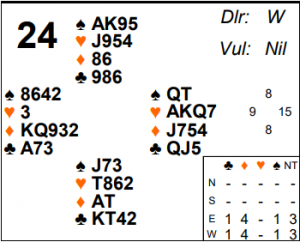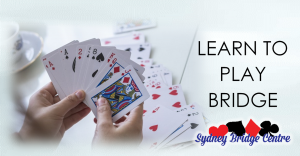City and Canada Bay – Monday Morning 19th August 2024.

I understand different boards were played at the two Monday sessions last week. This is a hand from the City session as that was the only one I had hand records for. Board 24 last week had a game available for East West although it was very close.
It’s likely to be an uncontested auction East West starting with 1NT from East. West should begin with stayman to look for a spade fit. After East responds 2♥ it’s still possible for there to be a spade fit (East could be 44 in the majors). But, as we’ll see, there’s no need to make any special bids to accommodate this.
West has 9 points but they are very good for a few reasons:
- There is a 5 card suit and honours in that long suit which will help establish it for tricks
- The points are A, K and Q – i.e. no jacks which tend to be overvalued at 1 point
- There is a shortage (valuable if there is a suit fit)
Accordingly, West is worth a game bid opposite 15-17 and he should simply bid 3NT over 2♥. A point often missed is that this actually shows 4 spades though! Why? Think about it logically. Why did West bid stayman? He doesn’t have heart support or he would have just raised hearts. If he had no major at all he wouldn’t have bothered with stayman in the first place – he’d just bid 3NT over 1NT. So the only reason for starting with 2♣ can be that he was looking for a spade fit. Therefore, if East is 44 in the majors he should trust his partner and convert 3NT to 4♠. On this hand of course he just passes 3NT.
What about if West didn’t have enough to game force but just had an invitational hand? He should still start with stayman but what happens afterwards may be a bit different and depends what you play 1NT – 2NT as. On a hand with this shape in the invitational range he could bid 2♠ (usefully played as invitational with 4 spades) and East can then evaluate his hand. See advanced section for more details.
Of course if you play other versions of stayman (extended, or puppet) to start with then things are different. Personally I think simple stayman is far better than extended stayman. The main reason being that none of the responses go above 2♠ – which in turn means you can afford to bid 2♣ on really weak hands where you know 1NT will be really bad and even a 4-3 major fit is likely to play better (the classic sort of hand to do that would be 4450 shape where you will just pass partner’s response – this is sometimes referred to as “garbage stayman”). If (as is the case with most versions of extended stayman) partner is allowed to respond 2NT or higher to your 2♣ though, then it’s no longer safe to bid on really weak hands.
What about the play in 3NT? At the 3 tables where 3NT was played each South led ♣2. East wins that in hand, knocks out the ♦A and hopes the defence can’t take 4 spade tricks. As it turns out they can’t so declarer should end up with 3 hearts, 4 diamonds and 2 clubs. A club lead is reasonable since the auction has revealed East has hearts and West has spades. If South was going to lead a major then a spade would be preferred because it’s leading around to declarer’s shorter suit rather than his known 4 card suit.
The defence are in fact perilously close to being able to beat 3NT on a spade lead. Believe it or not you just have to give North the ♠6 instead of the ♠5! Although it’s still not easy for them. See advanced section for why that makes a difference.
A few tables played the hand in diamonds. That should make 10 tricks losing 2 spades and ♦A. After trumps are 2-2, declarer can discard both West’s small clubs on ♥KQ and ruff 2 spades in East. He doesn’t need to risk the club finesse. Had trumps been 3-1, however, he can only ruff 1 spade so he should discard a spade and a club on ♥KQ and then take the club finesse.
Key points to note
- A good 9 points is usually enough for game opposite a strong NT.
- Simple stayman is still one of the best conventions in existence – it also allows you to bid it on really weak hands safely.
- 1NT-2♣-2♥-3NT should show 4 spades so opener with 44 in the majors can convert to 4♠.
- 1NT-2♣-2♥-2♠ is usefully played as invitational with 4 spades.
- It can be necessary for the defence to unblock higher cards to enable them to continue to cash a suit. This is often not easy to see at the table though!
More advanced
What if West had been slightly weaker and not able to force to game? Now he should make an invitational bid after stayman. What that is depends on the rest of your system. If you play an immediate bid of 2NT over 1NT as invitational then he can bid 2NT over 2♥ and, using the same logic as above, this will imply spades (because he hasn’t raised hearts and he didn’t just bid 2NT initially).
These days, however, it’s a lot more common to use 2NT directly over 1NT as something else (e.g. a minor suit transfer). Now the inference that West holds spades doesn’t apply. That’s because this time a general invite always goes through stayman whether or not it has a 4 card major. So the solution to West’s dilemma if he has spades is for the sequence 1NT-2♣-2♥-2♠ to be invitational with exactly 4 spades (had he had 5 he could of course have started with a transfer followed by 2NT). By inference this then means that 1NT-2♣-2♥-2NT actually now DENIES spades. Over 2♠ East can pass or bid 2NT with minimums. Or he can bid 4♠ or 3NT with maximums. There’s room for other bids too – perhaps a further trial bid to evaluate between 3♠ or 4♠.
How might North South attempt to take 4 spade tricks in defence? They would need to start with North cashing ♠AK. If South still holds ♠J at this point, then he scores that and ♦A but that’s all. Suppose South deliberately unblocked ♠J? Now when South gets in with ♦A he leads a low spade through the remaining 2 in West. This is why that ♠5 and ♠6 are so important! On this hand it’s no good. North has ♠95 and West ♠86. So West still has a spade stop. But had it been the other way around North would hold ♠96 sitting over West’s ♠85 and could score two more tricks. However, there’s one further catch! South also needs to have unblocked ♠7. If he doesn’t do so then when he leads it declarer simply doesn’t cover and North cannot afford to overtake with the ♠9 – the suit is blocked for North South. It’s almost impossible in practice for the defence to do this because South would have to lead the ♠J or ♠7 at trick one and the natural lead from his holding is ♠3. Indeed there are many layouts where leading the ♠J could be disastrous and leading the ♠7 could confuse partner as it make not then look like South has an honour. So this hand is more a theoretical exercise than a practical one!
Julian Foster (many times NSW representative)
 office@SydneyBridgeCentre.com
office@SydneyBridgeCentre.com


 Renew Your Membership
Renew Your Membership Top up your PP online
Top up your PP online Online Payment Instruction
Online Payment Instruction Look up the Pianola Results
Look up the Pianola Results Login to Pianola
Login to Pianola (02) 9264 6884
(02) 9264 6884 0487 350 160 (text only)
0487 350 160 (text only)